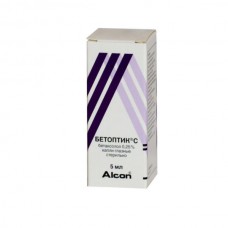Expiration date: 11/2026
The composition and form of issue:
Eye drops, 1 ml contains betaxolol hydrochloride 2,8 mg (corresponds to 2.5 mg betaxolol)
auxiliary substances: benzalkonium chloride, mannitol, carbomer 974 P, polystyrenesulfonate acid, boric acid, disodium edetate, N-lauroylsarcosine, hydrochloric acid, sodium hydroxide (for raising pH), purified water
in vials-droppers-plastic 5 or 10 ml in a cardboard pack 1 bottle.
Eye drops, 1 ml contains betaxolol hydrochloride 5.6 mg (corresponds to 5 mg of pure betaxolol)
auxiliary substances: benzalkonium chloride, acid hydrochloric/sodium hydroxide (to adjust pH), distilled water
in vials of 5 ml (with dropper cap) in the paper cartons 1 a bottle.
Description pharmaceutical form:
Transparent colorless or slightly yellowish solution.
Description pharmacological action:
Selective beta1-blocker without intrinsic sympathomimetic activity. It has no membrane stabilizing (local anesthetic) activity.
The local application betaxolol reduces both elevated and normal intraocular pressure (IOP) due to reduced production of intraocular fluid.
The onset of antihypertensive effect was observed 30 minutes after instillation, and maximum IOP reduction of approximately 2 h After a single instillation effect on the IOP is maintained for 12 h Betaxolol in comparison with other beta-blockers, does not cause a reduction of blood flow in the optic nerve.
Betaxolol does not cause miosis, accommodation spasm, night blindness, the effect of "veil" before the eyes (unlike miotikov).
Indications:
- intraocular hypertension
- open-angle glaucoma.
Can be used in the treatment of patients with open-angle glaucoma and intraocular hypertension in combination with pathology of the respiratory tract.
Contraindications:
Individual hypersensitivity to product components.
Caution: sinus bradycardia, AV blockade II–III degree, cardiogenic shock, severe heart failure, myasthenia gravis, diabetes mellitus.
Application of pregnancy and breast-feeding:
Sufficient experience in use of the drug during pregnancy, breast-feeding is not. Possible to use Betoptic for the treatment of pregnant and breastfeeding mothers by appointment the attending physician if the expected therapeutic effect exceeds the risk of possible side effects.
Side effects:
Local: the most common short-term discomfort in the eyes after instillation, and lacrimation. In some cases, point keratitis, reduced corneal sensitivity, photophobia, tearing, itching, dryness of eyes, redness of eyes, anisocoria and photophobia.
Systemic reactions (such as insomnia, depressive disorders) are rare.
Drug interactions:
Patients receiving eye drops Betoptic and at the same time taking other beta-blockers orally, the risk of side effects may be higher (both systemic and local) due to possible additive effects. Such patients should be under close medical supervision.
In combination with these drugs, depleting stocks of catecholamines as reserpine, may experience increased blood pressure lowering and bradycardia.
Caution must be exercised in a joint application betaxolol and adrenergic psychotropic drugs.
Method of application and dose:
Into the conjunctival SAC. 1-2 drops 2 times a day.
In some patients, stabilization of IOP occurs within a few weeks, so it is recommended to control it within the first month of treatment.
If the target IOP is not achieved with monotherapy Betoptic should designate additional therapy.
Overdose:
In case of contact with eyes, excessive amount of the drug is recommended to wash the eyes with warm water.
Precautions:
Sufficient experience in use of the drug in children. Application Betoptic for the treatment of children perhaps for a doctor, if the expected therapeutic effect exceeds the risk of side effects.
Special instructions:
Diabetes. Beta-blockers should be used with caution in patients prone to hypoglycemia, because these drugs can mask symptoms of acute hypoglycemia.
Thyrotoxicosis. Beta-blockers may mask some symptoms of hyperthyroidism (e.g. tachycardia). In patients with suspected thyrotoxicosis should not be abruptly canceled, beta-blockers, as this may cause increased symptoms.
Muscle weakness. Beta-blockers can cause symptoms similar to those of myasthenia gravis (e.g. diplopia, ptosis, generalized weakness).
Surgery. Before planned operation beta-blockers should be gradually (not simultaneously!) cancelled for 48 h before General anesthesia, because during General anesthesia, they can reduce the sensitivity of the myocardium to sympathetic stimulation necessary for the heart.
Pulmonology. Caution must be exercised in the appointment of beta-blockers in patients with severely reduced function of the respiratory system. Despite the fact that clinical studies have shown no effect betaxolol on respiratory function, one should not exclude the possibility of hypersensitivity to the drug.
The risk of anaphylactic reactions. Patients, receiving beta-adrenoblokatora, may have a history utopia or anaphylactic reactions. In the case of repeated reactions, such patients may be insensitive to the usual doses of epinephrine required for the relief of anaphylaxis.
The drug should be used with caution in patients with Raynaud's syndrome and pheochromocytoma.
Upon instillation in the eye beta-blockers can get into the blood system. Thus, beta-blockers can have the same side effects as with in/in and oral appointment.
Described cases of severe respiratory and cardiovascular disorders, including death from bronchospasm in patients with bronchial asthma and death from heart failure.
Betoptic shows minimal impact on AD and heart rate. However, care should be taken when assigning its patients with AV block or heart failure. Treatment should be discontinued at the first signs of decompensation of the cardiovascular system.
Patients who use contact lenses should be removed before instillation of the drug and dressing again only after 20 min, since the preservative contained in the preparation, may be deposited in the lens and have an adverse effect on eye tissues.
If the patient after using the drug temporarily reduces the clarity of vision, to restore it is not recommended to drive and engage in activities requiring increased attention and reaction.
MANUFACTURER
C. and. Alcon-Couvreur N. V., B-2870 Puurs, Belgium.
Storage conditions:
(in vertical position).



